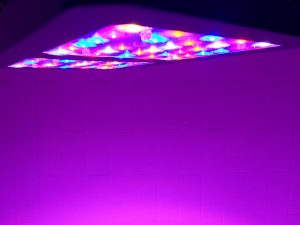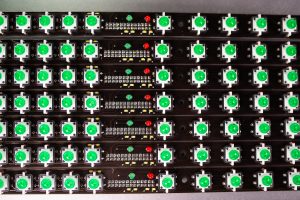LED grow lights offer many advantages over traditional grow lighting including:
- Less Power
- Low Heat
- Efficiency
- Lower HVAC Costs
- Proximity to Plants
- Spectrum
- Controllability of Spectrum, Dimming, Schedules
- WiFi and Remote Operation
- All-in-One Package
- Modularity
- Easy to put in
- Daisy-Chainable
- Different Shapes/Designs
- Different Configurations
- Long Lifetime
- Solid State
- Waterproof and Dustproof
- Recyclable
- Faster Finishing, Better Quality, More Resin, Increased Density
- Return-on-Investment
Let’s take a more in-depth study of these benefits.
Less power
The primary reason growers chose LEDs over traditional lighting is thanks to the electricity savings. LED grow lights consume fewer watts to supply about the identical amount of usable light as HID bulbs. this can be one of the most advantages of growing with LEDs. A grower can use LEDs to deliver more PAR to their plants per watt of electricity.
Keep in mind that a number of the wattage that the fixtures draw isn’t all converted to light. a number of the energy is lost as heat. Furthermore, additional wattage is also won’t to power cooling fans that blow radiant heat aloof from the warmth sinks.
The average efficient LED grow light draws about 32 watts to hide one area unit of grow space for flowering plants. Compare this to a typical HID fixture which is able to ring in at 62.5 watts per area unit (assuming a 4’ x 4’ area, or 16 square measure coverage area).
The energy-saving that growers can expect from employing a very efficient LED grow light, rather than an HID grow light, is around 48%. This percentage may drop to as low as 20% with less efficient LED grow lights. this massive energy savings only takes into consideration the savings growers attain when using LED fixtures. It doesn’t account for other environmental factors where growers can save energy. as an example, less ventilation and air-con is required, or are often foregone completely in certain situations reckoning on the scale of the setup and ambient temperatures. Total power savings may rise well above 50% within the best scenarios.
Light-emitting ceramic fixtures rank near LEDs in terms of wattage required per area unit of grow space. A 315 watt LEC will cover a 3’ x 3’ (9 square foot) area which equates to 35 watts per sq ft. Growers can expect a 630 watt LEC to effectively illuminate a 4’ x 4’, or maybe a 5’ x 5’ area with slightly less intensity. Expect about 39 watts per square measure for 4’ x 4’ coverage and 25 watts per square foot over a 5’ x 5’ area with
The energy savings is null when comparing LEDs to LECs. For this reason, some growers say light-emitting ceramics pose a threat to LEDs since they’re even as energy-efficient as LEDs. But there are many other benefits to LEDs that LECs don’t possess. Those advantages form up most of this text.
Furthermore, growers can expect to work out an increase in diode efficiency over the following several years, allowing more µmol per watt to be exuded. With a 48% energy savings over traditional grow lighting at this present, expect over 50% energy savings at a lower cost per watt in early 2018 with a number of the most effective LED grow lights.
The increase in diode efficiency could be a result of technological innovation and was accurately predicted by Dr. Roland Haitz. Haitz law states that each decade, the value per unit of useful light falls by an element of 10, while the number of sunshine generated per LED package rises by an element of 20, for a given wavelength. In other words, the price of producing and buying LEDs will decrease significantly, while efficiency will and increase dramatically. Following this trend LED light output will double every 3 years. The trend is driven by advances in semiconductors, material science, and optic technology.
Extra energy savings can even be attained since less ventilation and/or air-con is required to stay in the area at a stable temperature.
Low Heat
Fewer watts mean less heat within the grow room. How do watts translate to heat? Well, one watt is equivalent to 3.41 BTU/h (British Thermal Unit per Hour) or BTU for brief. The more watts that a fixture draws, the more heat it gives off. For comparison, a 300-watt fixture emits 1023 BTU while a 1000 watt fixture emits 3412 BTU’s. Although, this can differ across fixtures and efficiencies. A 1000 watt LED fixture might not exude the identical amount of warmth as a 1000 watt HID fixture because the LED grow light converts more energy to light and fewer to heat.
On average, LEDs provide a lower wattage per sq ft than HID fixtures and thus will push less heat into the encircling environment. Temperature management could be a gorilla that growers must manage. If you don’t tame the gorilla. it’ll wreak havoc on your plants.
Ideal ambient temperatures are critical for plant development and metabolism. High temperatures can stress out your plants which may cut down growth, cause wilting, and even kill them if the temperatures are very high even in an exceedingly short time span.
An advantage of LEDs is that you simply can run ambient temperatures on top of you’d with traditional lighting since LEDs emit less forward heat and can raise your leaf surface temperature (LST) to the maximum amount as HID lighting.
Leaf surface temperature is suffering from ambient temperature, but is additionally full of the invisible longwave radiation, or heat, from the sunshine source. High-intensity discharge lights emit excess infrared emission at around 820nm that’s not used for photosynthesis. the surplus heat enters the ambient environment and strikes the leaves.

Unlike HID sources, LED grow lights rarely contain diodes with wavelengths past 730nm. there’s only a little amount of warmth directed toward the plants that are emitted from the diodes. the remainder of the warmth is that the ambient heat from the panel. Place your hand underneath an LED panel and under an HID fixture to feel the difference in radiant heat. The LED panel’s heat will feel slightly warm, but the HID fixture will feel very warm.
Less efficient spectrums will heat up the leaves more, while more efficient spectrums will cause a lower LST. Growers who use HID lights will, therefore, must keep their ambient temperatures cooler to keep up a lower LST. In contrast, LED growers might consider keeping their ambient temperatures higher, by up to 10° F (as high as 85° F ambient temperature) to take care of an analogous LST as HID growers.
Ideal ambient temperatures are critical for plant development and metabolism. High temperatures can stress out your plants which might abate growth, cause wilting, and even kill them if the temperatures are very high even during a short time span.
Therefore, the perfect LST is difficult to pinpoint since LST parameters exist in an interdependent system and may rely on plant variety. Perhaps, we are going to know more about ideal LSTs as research increases.
Efficiency
Light-emitting diodes are up to 40%-60% more efficient at converting energy to usable light compared to HID lights. The high-efficiency characteristic of LEDs allows lower energy draw and a coffee heat signature. LEDs convert about 40%-60%+ of their energy to light, while the opposite energy is given off as heat. HID bulbs only convert only about 20%-40% of their energy to usable light. What does this mean for the grower? Fewer watts are needed to supply the identical amount of sunshine as traditional grow lamps.
Another way to seem at efficiency is thru PAR efficacy which is usually reported in μmol/J (micromol per Joule). PAR efficacy is more important than using electrical watts to match grow lights because a fixture can draw lots of watts, but that wattage won’t directly translate to high useable light. Using wattage to see the quantity of useable light and the growing area may be a relic from the times of HID.
Why does efficiency matter over wattage? Consider two fixtures that cost the identical amount of cash per watt. Fixture ‘A costs $1500, draws 500 watts, and emits a mean PPF of 700 μmol/s. Fixture B costs $2000, draws 666 watts, and emits a median PPF of 500 μmol/s. One can already start to determine the problem—more money is being spent on Fixture B which pulls more watts and doesn’t emit the maximum amount of usable light as Fixture A. The efficiency of Fixture A is 1.4 μmol/J (1 watt = 1 Joule), while the efficiency of Fixture B is merely 0.75 μmol/J. Conclusion: Fixture A costs 25% but Fixture B, emits 28% more light and is 46% more efficient. Using an LED grow light with high PAR efficacy will economize on electricity costs.
Lower HVAC costs
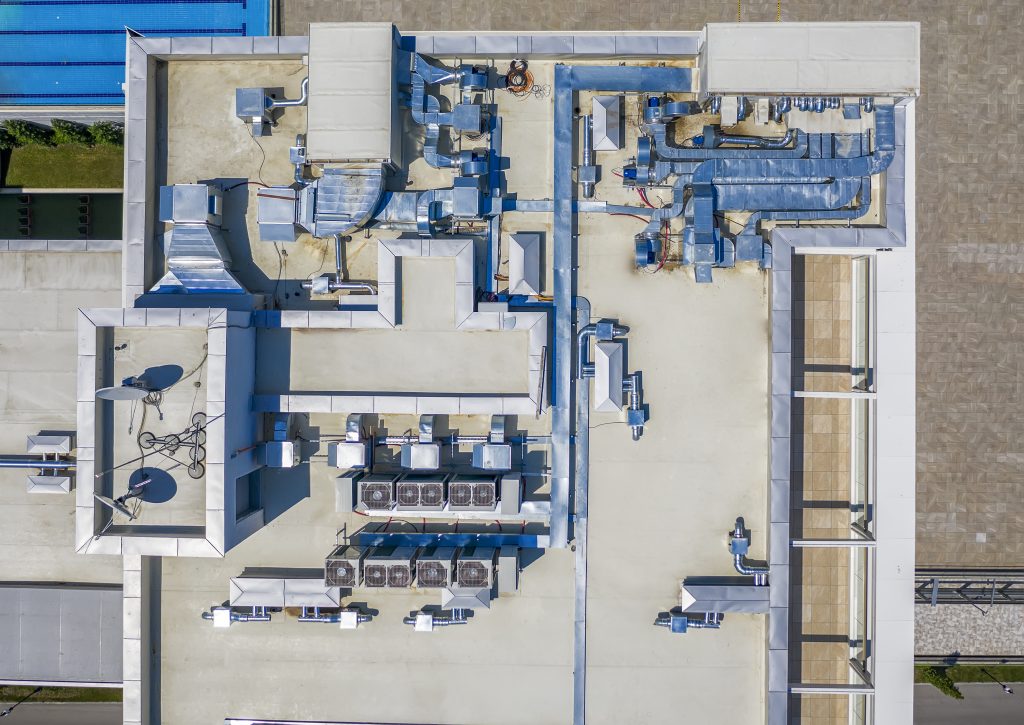
Since growers are ready to use fewer watts to deliver the identical amount of sunshine to their plants, they’re going to have lower capital and operating HVAC costs. Larger grow rooms would require less air-con to chill the area. Growers have reported a discount of fifty in air-con costs when switching to LEDs. Not only does the A/C reduction stem from the efficient lighting technology of LEDs, but the very fact that growers can run their grow room temperatures up to 10° F warmer when using LED grow lights.
Smaller grows may consider removing air-con from their grow setups entirely, since it should be possible to get ideal to grow temperatures with only using the warmth given far from the LEDs grow fixtures.
Furthermore, growers might consider reducing the facility needed to run ventilation into and thru their grow areas because ambient temperatures are lower when using LED grow lights. this is often assuming ventilation is getting used to cool down the grow area additionally to providing adequate air exchange. the next rate of air exchange can assist keep ambient temperatures cooler if the intake air is cooler than the air inside the grow environment.
Proximity to Plants
LED grow lights are placed closer to plants than HID lights thanks to their low heat output—sometimes as close as some inches! this is often advantageous to growers growing in areas limited by height. This feature also allows growers to position the lights closer to plants to make sure optimal light penetration deep into the cover. counting on the PPF of the sunshine, placing the fixtures too close may result in the light burn that the manufacturer’s recommendations on distance should be followed.
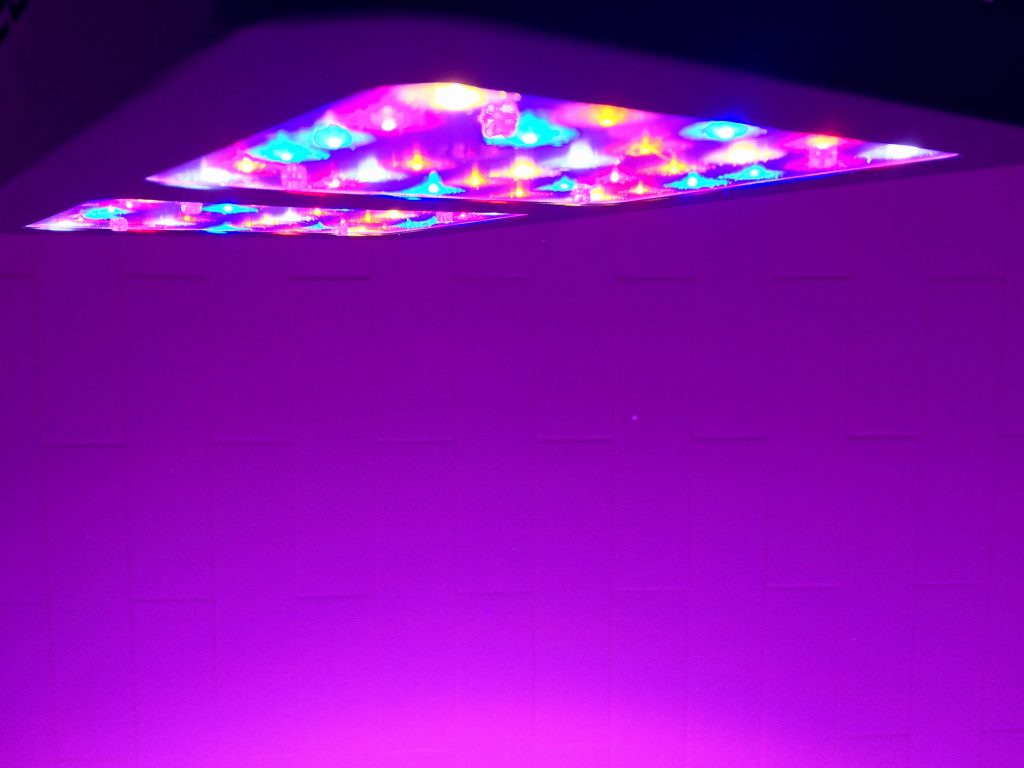
Be aware that the form and intensity of the fixture will determine how close you’ll place the unit to your plants. Smaller, “box-shaped” fixtures perform best when placed further above the plant canopy to permit the sunshine to spread before it reaches the plants. Though this can depend upon the beam angle of the LEDs within the fixture. A wider beam angle will allow the grower to position the fixture closer to the plants, while a smaller beam angle should be used if the fixture is going to be placed farther from the plants.
Larger, low-profile fixtures like the NextLight Mega, are designed to be placed near the plant canopy since the sunshine is detached over a bigger extent on the panel. The unique design of those fixtures also allows for an evener lighting footprint.
Spectrum
Spectrum is essential to maximizing your plant’s potential. While intensity level and duration could also be the foremost important considerations driving photosynthesis, the spectrum can affect a plant’s shape furthermore as flower density, quality, and potency. Certain light wavelengths and wavelength ratios also drive photomorphogenesis effects like rate of growth, stretching, and photoperiodism.
Plant growth and the response were long limited to the sort of lighting whether metal halide, air mass sodium, or fluorescents. Nowadays, LEDs allow the grower to solicit varying plant responses betting on the intensity and specific wavelengths and wavelength ratios included within the fixture. this is often a large leap in lighting technology.
In general, cooler, or more blue spectrums, are used for vegetative growth, while warmer, more red spectrums, are used for flowering. Full-spectrum white-light fixtures have grown in popularity over the previous few years as diode efficiency has increased. Some growers use a 3000K, 3500K, or 4000K for full-cycle grows counting on the result they’re looking to get or the strain they’re growing.
Whatever the spectrum of the LED grow light, they’re a boon compared to the normal spectrums of HID grow lights. LEDs offer a more full and complete spectrum that benefits plant growth from seed to reap.
Controllable Spectrum, Dimming, Schedules
An increasing number of manufacturers are incorporating spectrum, dimming, and scheduling (SDS) control into their LED grow lights. a pair of samples of this technology include the Kind LED K5 series, the Ulight 630, the Gavita and Fluence lights also offer these benefits.
Spectrum control
Spectral manipulation is from the flexibility to independently control each panel’s spectrum. this can be a feature unique to LED grow lights. Traditional grow bulbs beam one spectrum within which can’t be manipulated. Many LED grow lights contain an array of colors, typically reds, blues, and whites, that may be turned on or off in any combination betting on the plant’s growth stage or variety/strain.
Dimming control
Many LEDs are dimmable from 1%, up to 100% intensity. Dimming control allows a customizable proportion of wavelengths to be introduced to the plants and might also assist in saving additional energy when full intensity isn’t required. for instance, the grower may opt to dim the blues by 50% while maintaining 100% red and white during flowering. One can also favor dimming all of the color channels to 75% during vegetative growth to scale back total power consumption.
Scheduling/timing
LED grow lights sometimes contain on-board scheduling (or timing), allowing the grower to program their spectrum and dimming schedules directly into the unit. This feature also reduces the necessity for an external timer since all timing is made into the fixture’s microprocessor. Scheduling allows the grower to manually choose the spectrum and intensity for every hour of the day in a very 24 hour period.
With SDS control one can use one fixture for seedlings, clones, vegetative growth and flowering while saving energy.
Wifi and Remote Operation
WiFi technology and remote operation of the grow fixtures make the spectrum, dimming, and scheduling possible. Most of those lights hook up with a WiFi network during which the grower can use a distance to set up the SDS options. Some lights use a smartphone app to manage the fixture’s SDS, while other brands have their own remote or controller.
All-in-One Package
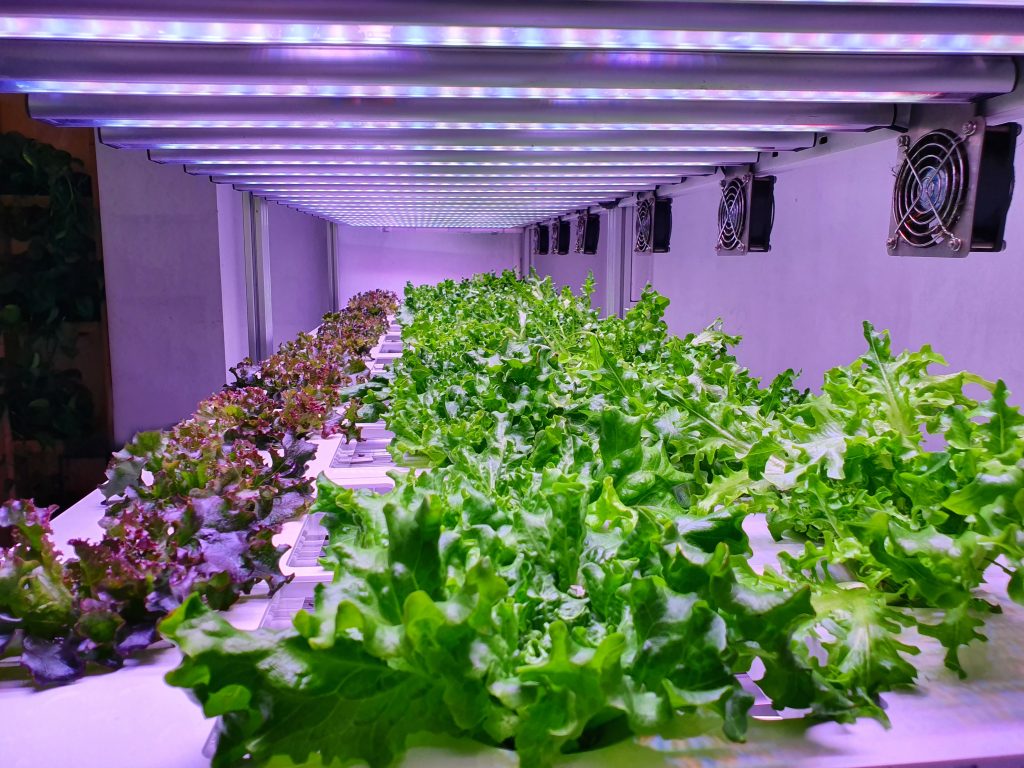
Traditional grow equipment requires the grower to buy a ballast, reflector, and bulbs. In contrast, LED grow fixtures are one integrated unit.
LED fixtures remove the majority of an HID grow setup and concentrates it into a slim panel. Unlike HID bulbs, frequent bulb changes don’t seem to be needed with LED grow lights. Simply hang it, plug it in, and begin growing.
HPS vs LED
Power: Ballast | Driver
Light source: HID bulb | LED diodes
Light director: Reflector | LED beam angle/optional secondary optics
Heat management: Ventilation | Heatsinks/cooling fans
Modularity
You might be thinking: “What happens if something breaks within the panel? Do I want a new unit?” In most cases, you don’t. Many LED grow panels are modular and if it’s a comparatively small problem, parts within the LED fixture are swapped out with new parts, these parts may include, but aren’t limited to the PCB boards, lenses, drivers, and fans.
LED panels are currently the foremost common variety of fixtures on the market. they sometimes have a removable back that offers growers access to the within of the panel if anything has to be fixed or replaced. Although rare, issues can occur and are fairly easy to repair. it’s always as simple as disconnecting the faulty piece, whether it’s a driver or failed LED board, setting up the new piece, and shutting the unit keep a copy. The modular system makes the LED light repair a 15-30 minute task.
Problems with non-modular LED grow lights may require the grower to send the fixture back to the manufacturer for repair.
Easy to put in
The “all-in-one-package” design of an LED grow light makes installation a full lot easier for little or large grows.
At a minimum, small to medium-sized grows only require an LED fixture and ventilation/air circulation. Simply enter the sunshine, hang it up, and ensure adequate airflow and stable temperatures. Growers shouldn’t worry about a ballast, hang the reflector, and worry the maximum amount about the grow space overheating thanks to the new temperatures exuded by an HID bulb.
Larger grows have a more complex setup than smaller grows since they have to consider the complete lighting system, electrical, HVAC, etc. However, when large farms use LED grow lights, they may install a smaller HVAC system since less cooling equipment is required because of the lower heat load of LEDs.
Daisy-Chainable
Some LED grow lights allow the grower to daisy-chain the units together to cut back the number of power cords returning to the socket. in a very daisy-chain setup, a grower may have one light plugged in so connect several more units to the primary unit serial.
Setting up a timer for one plug is less complicated than using it several times for multiple plugs.
Be aware of overloading the electrical device when daisy-chaining lights together. The more watts a unit consumes, the fewer fixtures are daisy-chained together. Typically, the manufacturer will state the utmost number of fixtures that will be connected together in a very 120V or 240V setup.
Different Shapes/Designs
LED grow lights are available in many sizes and shapes. it’s common to search out LED lights on the market that cover the square measure equivalents of the subsequent HID bulbs—400 watts, 600 watts, and 1000 watts. Therefore, these LED lights gravitate toward a more square-shaped structure and can cover a 4+ square foot, 9+ sq ft, and 16+ square measure area.
While most growers will grow in an exceedingly square space, some growers have an area where they’d take pleasure in a more rectangular lighting footprint. Either, two grow lights with a square footprint may be placed side-by-side or a rectangular-shaped grow light are often wont to cover the space. In general, more units are best since it’ll create an evener lighting footprint.
LEDs may be accustomed replace fluorescent T5 tubes with an on-the-spot one-to-one replacement where the grower can swap out the tubes for a T5 LED. rather than 54-watt fluorescent tubes, the fixture’s wattage consumption would be cut in half when retrofitting them with the 24 watt LED tubes.
Furthermore, LED grow light bars, like the Arize series from GE lighting, are designed for vertical gardening, but make great supplemental lighting lights for hard-to-light places or are also mounted on shelf bottoms for seedlings and little plants.
Different configurations for various lighting applications
Most LEDs are set up to direct light down into the cover from an overhead source. this is often the foremost efficient for photosynthesis since plants absorb light from the highest of their leaves. Since LEDs don’t get extremely popular, they will be placed near plants. Their customizable configuration allows them to be designed for areas that are difficult to illuminate.
Some companies offer LED bar lights that may be hung in conjunction with the most lighting source to focus on the perimeters of the grow which will not be receiving adequate light. The bar lights are often placed vertically within the corners of the grow space to extend penetration and open up the cover because the plant will grow slightly toward the lights. Opening up the cover can increase light penetration from the sunshine source above, boost photosynthesis during vegetative growth, and deliver more light to smaller flowers that are shaded by the highest of the cover during flowering.
One of the most recent additions to supplementary LED grow lighting includes interlighting modules. These modules are typically 8-ft long (some are 4-ft long) and contain LEDs on each side of the bar. They’ve hung horizontally from wires above and placed within the canopy of taller, bushier plants like cucumber and tomatoes.
We have also seen prototypes of LED light ‘sticks’ that hang vertically and may be placed within the canopy in or between plants. LEDs lie the length of the ‘stick’ and beam light altogether directions into the cover. To picture this, consider placing a fluorescent tube vertically into the cover. The LED stick works in a similar way.
Long Lifetime
Most LED grow lights on the market contain LEDs that may last around 50,000 hours. Some manufacturers use LEDs that last up to 100,000 hours or more. this is often reminiscent of almost 10 years of use (at 50,000 hours) or almost 20 years of use (at 100,000 hours), respectively. Compare this to MH bulbs which last a mean of 10,000 hours or HPS bulbs which have a lifespan of 16,000 hours more or less.
Due to most LED panel’s modular build, if a grower still had the LED light at the top if its lifespan, they’ll be able to swap out the old LEDs for brand spanking new ones and carry on growing.
Solid-State lighting
LEDs are considered solid-state lighting (SSL). they’re not powered by filaments, plasma, or gas, but instead are powered by a two-lead semiconductor. the sole moving “parts” are the electrons that pass from the n-type to the p-type to form the sunshine that’s emitted from the diode.
Because there aren’t any moving parts in an LED, they’re subject to external shock with little or no damage to the diodes themselves, unlike other kinds of lighting like HID or fluorescent bulbs.
Waterproof and dustproof
Many LED grow lights are rated waterproof and dustproof—typically expressed because of the Ingress-Protection code, or IP for brief. lots of fixtures on the market are dust-tight and watertight with an IP code of IP65. the primary number—6—indicates that the fixture is “dust tight”. The second number—5—states that the fixture can withstand water projected from 6.3 mm nozel in any direction with no harmful effects. There are some fixtures that don’t seem to be as watertight as others and will only have a rating of IPX4 or IP63, indicating that they will only be sprayed and splashed with water, respectively.
Most commercial growers prefer waterproof fixtures, where this won’t be as large of a priority for the standard home grower.
Recyclable
High-pressure sodium and metal halide bulbs contain mercury and release toxic vapors upon breaking. These bulbs require safe disposal to make sure they are doing not leach carcinogens into the environment.
On the opposite hand, LEDs don’t contain mercury and are considered safe. this is often mostly true—they don’t contain mercury, but they’re not completely metal-free. A 2010 study by the University of California Irvine, found very high levels of lead in low-intensity red LEDs and high levels of copper, nickel, and silver in other colors of LEDs, apart from in low-intensity yellow. LEDs are solid-state lighting and therefore the diodes are typically very small so don’t risk breaking. Yet, if the diodes find themselves within the environment and break down, the metals can leach.
Faster Finishing, Better Quality, More Resin, Increased Density
Many LED growers report faster flower growth and development with some strains concluding to five days sooner when grown with LEDs compared to HPS. Other growers report a better concentration of trichomes with a superb terpene profile…one that rivals plants grown with HPS. the upper concentration of terpenes is probably going thanks to the reduced temperatures from LED lights and increased amounts of blue within the spectrum. additionally, flower density is commonly reported as higher because of the increased blue wavelengths within the spectrum, reducing stretch and creating more compact flowers.
Fast Return on Investment
When do growers see a return on investment (ROI) for his or her LED grow light installation? There are many factors to think about for ROI that aren’t associated with the direct monetary savings of electricity. as an example, consider the price savings of running fewer air-con thanks to the lower heat load when using LEDs. Furthermore, growers have reported that their plants are initiating flower development earlier—allowing a quicker turnaround—and producing higher-quality flowers when grown under LEDs. The high-quality flower is worth quite an average flower.
Return on investments will vary significantly for growers looking on if they’re a tiny low closet grow, a medium-sized home grow, or an outsized commercial farm.
Additional Benefits
Constant Cycling
Turning on and off traditional bulbs quite a typical number of times can shorten their lifetime significantly. However, LEDs is cycled on and off without compromising the lifetime of the diode.
Controllable Beam Angle
Optics will be placed over the diodes to narrow the main focus and increase the intensity level. this is often analogous to an HID reflector but better since the beam angle and intensity are controlled.
Low Maintenance Costs
LEDs grow lights can last 10 years or more without the necessity for any maintenance or replacements. Once the fixture is set up, the diodes don’t have to get replaced, unlike HID bulbs which require replacing every several thousand hours.
Do you have any additional benefits that you simply would raise the list? allow us to know below.
Also, if you enjoyed this content please share it! It does signal to us that you guys are finding this content useful and helps us produce more content like this!
Thank you for reading this and I’ll see you at the next one!



